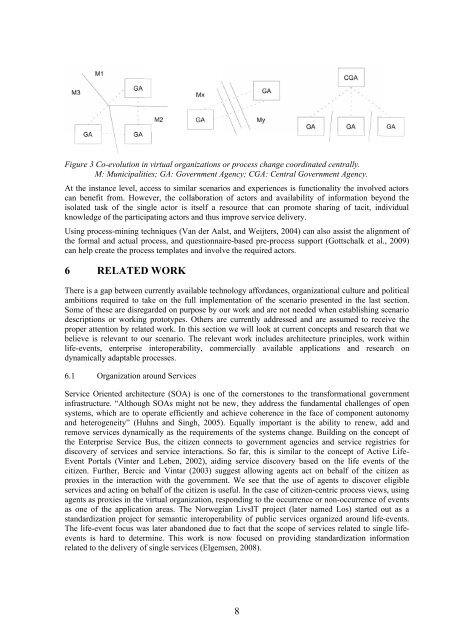Multi-channel provisioning of public services - Department of ...
Multi-channel provisioning of public services - Department of ...
Multi-channel provisioning of public services - Department of ...
You also want an ePaper? Increase the reach of your titles
YUMPU automatically turns print PDFs into web optimized ePapers that Google loves.
Figure 3 Co-evolution in virtual organizations or process change coordinated centrally.<br />
M: Municipalities; GA: Government Agency; CGA: Central Government Agency.<br />
At the instance level, access to similar scenarios and experiences is functionality the involved actors<br />
can benefit from. However, the collaboration <strong>of</strong> actors and availability <strong>of</strong> information beyond the<br />
isolated task <strong>of</strong> the single actor is itself a resource that can promote sharing <strong>of</strong> tacit, individual<br />
knowledge <strong>of</strong> the participating actors and thus improve service delivery.<br />
Using process-mining techniques (Van der Aalst, and Weijters, 2004) can also assist the alignment <strong>of</strong><br />
the formal and actual process, and questionnaire-based pre-process support (Gottschalk et al., 2009)<br />
can help create the process templates and involve the required actors.<br />
6 RELATED WORK<br />
There is a gap between currently available technology affordances, organizational culture and political<br />
ambitions required to take on the full implementation <strong>of</strong> the scenario presented in the last section.<br />
Some <strong>of</strong> these are disregarded on purpose by our work and are not needed when establishing scenario<br />
descriptions or working prototypes. Others are currently addressed and are assumed to receive the<br />
proper attention by related work. In this section we will look at current concepts and research that we<br />
believe is relevant to our scenario. The relevant work includes architecture principles, work within<br />
life-events, enterprise interoperability, commercially available applications and research on<br />
dynamically adaptable processes.<br />
6.1 Organization around Services<br />
Service Oriented architecture (SOA) is one <strong>of</strong> the cornerstones to the transformational government<br />
infrastructure. “Although SOAs might not be new, they address the fundamental challenges <strong>of</strong> open<br />
systems, which are to operate efficiently and achieve coherence in the face <strong>of</strong> component autonomy<br />
and heterogeneity” (Huhns and Singh, 2005). Equally important is the ability to renew, add and<br />
remove <strong>services</strong> dynamically as the requirements <strong>of</strong> the systems change. Building on the concept <strong>of</strong><br />
the Enterprise Service Bus, the citizen connects to government agencies and service registries for<br />
discovery <strong>of</strong> <strong>services</strong> and service interactions. So far, this is similar to the concept <strong>of</strong> Active Life-<br />
Event Portals (Vinter and Leben, 2002), aiding service discovery based on the life events <strong>of</strong> the<br />
citizen. Further, Bercic and Vintar (2003) suggest allowing agents act on behalf <strong>of</strong> the citizen as<br />
proxies in the interaction with the government. We see that the use <strong>of</strong> agents to discover eligible<br />
<strong>services</strong> and acting on behalf <strong>of</strong> the citizen is useful. In the case <strong>of</strong> citizen-centric process views, using<br />
agents as proxies in the virtual organization, responding to the occurrence or non-occurrence <strong>of</strong> events<br />
as one <strong>of</strong> the application areas. The Norwegian LivsIT project (later named Los) started out as a<br />
standardization project for semantic interoperability <strong>of</strong> <strong>public</strong> <strong>services</strong> organized around life-events.<br />
The life-event focus was later abandoned due to fact that the scope <strong>of</strong> <strong>services</strong> related to single lifeevents<br />
is hard to determine. This work is now focused on providing standardization information<br />
related to the delivery <strong>of</strong> single <strong>services</strong> (Elgemsen, 2008).<br />
8
















